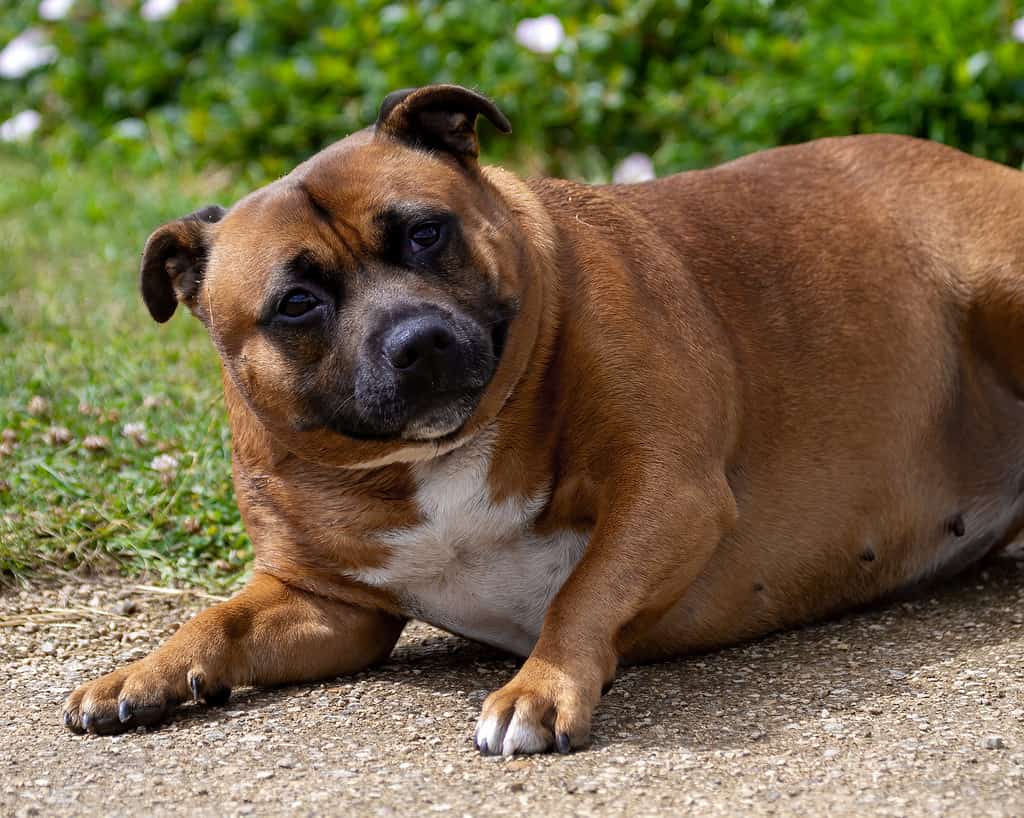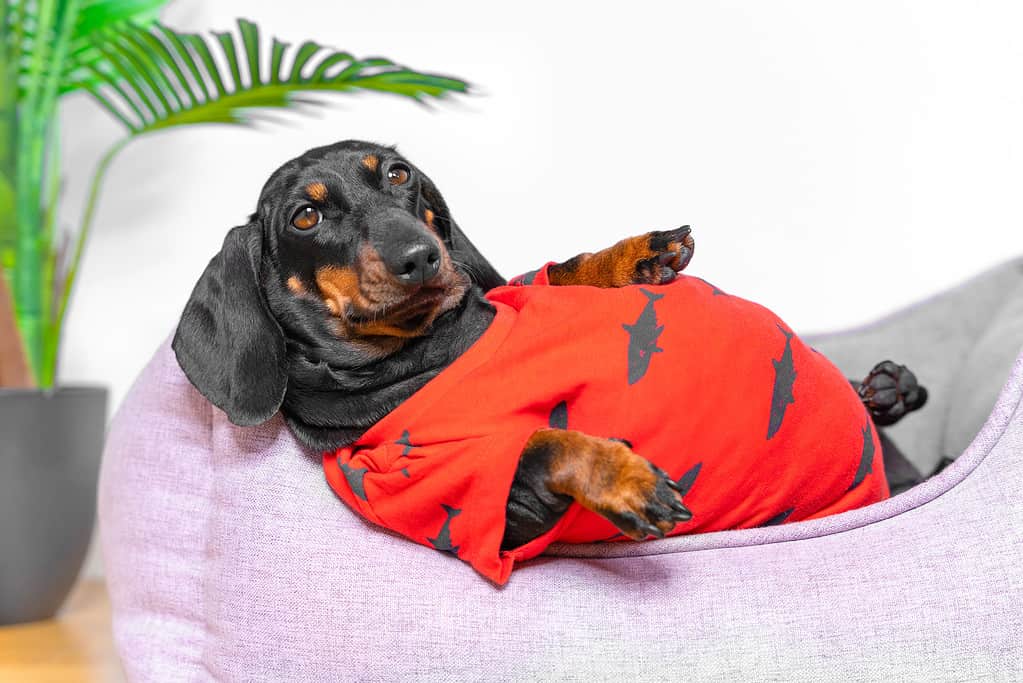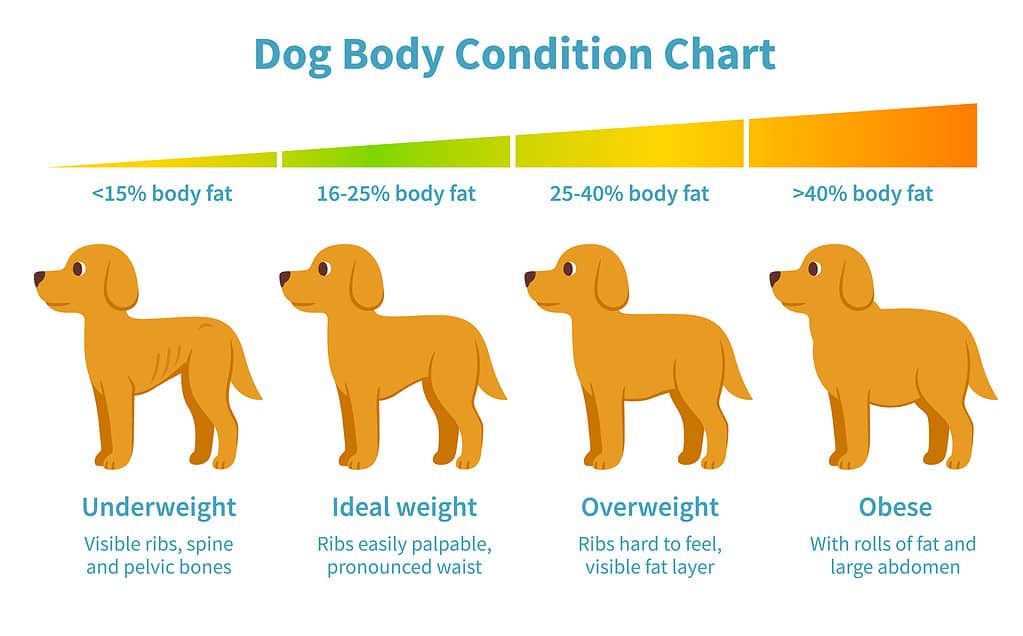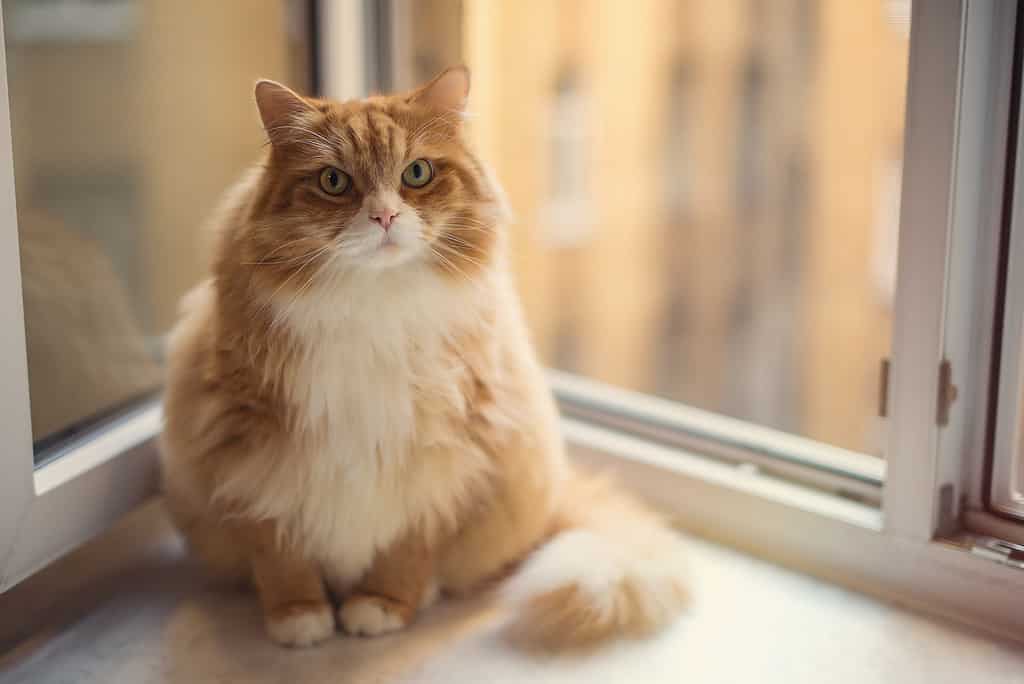
Cats are more likely to become obese than dogs because they sleep 12 to 18 hours a day.
©Serhii Ivashchuk/iStock via Getty Images
Pets are one of life’s great pleasures. Dogs provide unconditional love, cats treat their human servants with admiration for tending to them, and small animals like rats and ferrets provide fun and mischief. Owning a pet is equivocal to raising a child. Any pet owner would agree that pets are their children. We’ll do anything to keep them safe and healthy.
Unfortunately, many of our beloved pets are obese. According to Forbes, 66% of American households have a pet as of 2023. And nearly 50% of those pets are obese. Parents love their pets with all their heart, so it seems inconceivable they would allow their children to become unhealthily overweight.
How are these pets getting so fat? What can pet parents do to help them lose weight? This article answers all those questions, so our animals can live their best life.
What Is Pet Obesity?

Some pet parents love to spoil their dogs with human scraps, treats, and a constantly full bowl.
©Sue Thatcher/iStock via Getty Images
Obesity is not the same as being overweight. Obesity occurs when a pet has so much body fat that it negatively impacts overall health. The excess weight damages energy levels, the body, and general welfare, leading to a low or poor quality of life. Obesity means weighing 30% more than ideal weight.
Humans and pets can live a perfectly healthy and happy life while being overweight. Being overweight is described as being approximately 10% over the ideal weight.
Negative Effects of Obesity
With obesity, the excess weight the pet has is harming their health.
Clear examples of negative effects on the body due to obesity are:
- Diabetes is due to improper nutrition from glucose and glandular complications.
- Respiratory issues arise from the body needing more oxygen to move.
- Risks of heart disease increase because the heart is working harder to pump blood and oxygen through the heavier body. Additionally, unhealthy foods clog arteries, making it even harder to pump blood.
- Additional stress on the body from the heart leads to high blood pressure.
- Arthritis forms because the joints struggle to support the excess weight.
- Gastrointestinal issues (GI issues) lead to vomiting, diarrhea, smelly poops, or colon complications.
- In old age, pets are left vulnerable to cancers in their spleen, liver, or digestive tract.
- Lower life expectancy
How Do Pets Become Obese?

Social media likes to portray overweight animals as cute, neglecting the many health risks.
©Ирина Мещерякова/iStock via Getty Images
The most common cause of obesity in pets is overfeeding. However, the problem is more than just portion control. Different pets require different amounts of food to fuel their bodies, and not every animal has the same nutritional needs. Common sense tells us that small dogs like cocker spaniels or chihuahuas should not eat as much food as a German shepherd or Greater Swiss Mountain dog.
Overfeeding
As we said, overfeeding is the first cause of pet obesity. It is easy to leave a full bowl of dry food for our pets. It makes feeding pets easy, but that solution is also the problem.
Dogs love to engorge themselves on food. Free-feeding pets allows them to eat their fill until they become overweight and obese. This habit of overfeeding is common in lizards, small mammals, and even ferrets.
Poor Quality Diet
A poor-quality diet is another component of pet obesity. When pets are fed an unhealthy diet, they have smellier poops and turn more unhealthy carbs into fat. The fat is stored in the body, leading to weight problems and dental problems.
It is a common myth that dry food is slimming for pets. In actuality, it is filled with so many preservatives and carbohydrates, that continuous feedings may lead to weight gain. When a pet eats a poor-quality diet with synthetic nutrients, preservatives, and artificial chemicals, they suffer from a poor quality of life.
Too Many Treats
Providing constant treats increases pet weight much faster. Treats in moderation is fine, but offering multiple treats every day is similar to giving a child candy and fatty snacks every day. It may taste good, but it comes at the cost of one’s health over time. Offering treats like table scraps also increases the pet’s chance of becoming obese.
Minimal Exercise
Domesticated dogs and cats are spoiled; they do not need to hunt for their food anymore. In the wild, animals are constantly on patrol or looking for food, keeping their bodies fit and slim.
Modern pets lounge on comfy furniture all day, napping intermittently and waking up to eat, stretch, and go back to sleep. Without a consistent level of physical activity and mental engagement, the food they eat turns to fat.
Medicine and Disease
Older animals may succumb to glandular diseases like hypothyroidism, wherein the adrenal glands do not produce enough thyroid. These diseases may have side effects including weight gain, which can lead to obesity.
Certain medications like Prednisone (a common steroid medication used to treat allergies or inflammation) have side effects linking to an increase in weight.
Genetics
Unfortunately, some pets are genetically more likely to become obese than others. This could be due to the efficiency of the pet’s body in absorbing nutrients.
For example, several dog breeds like golden labs, Labrador retrievers, cocker spaniels, dachshunds, beagles, boxers, pugs, and bulldogs have a higher risk of obesity as they age. Their bodies slow down, while they continue eating the same amount.
Domestic shorthair and longhair cats are equally as likely to become obese because they live a sedentary life. Maine coons naturally have larger bodies, but they can also become obese.
How to Tell If a Pet Is Obese

Every animal has different ideal weight ranges based on their breed and species.
©Sudowoodo/iStock via Getty Images
Determining whether a pet is obese or overweight is tricky business. Veterinarians are trained to understand the slight differences in pet weight, and pet scales can be found online to help detail the ideal weight for specific breeds and species. Pet parents need to communicate with pet care professionals regarding their pet’s ideal weight.
Typically, an easy way to tell a pet’s weight is by looking for these signs:
Severely Underweight
- Bones and ribcages are easily seen and felt.
- There is little to no muscle mass on the body.
Underweight
- Ribs are slightly visible and easily felt
- Wait and abdomen are noticeably seen
Healthy Weight
- Ribs are not seen but can be felt with petting
- Little to no body fat deposits
- Noticeable waistline and curve of the body from ribs to hips
Overweight
- Ribs are not seen and are slightly difficult to feel.
- The waist is barely visible with the contour of the body being straight across.
- Sides thicker with some fat
Obese
- Also called grossly overweight
- No waistline at all
- Large fat deposits across the body
- Distending or hanging abdomen
- Ribs cannot be felt
Helping An Obese Pet Lose Weight

Senior pets have a high risk of becoming obese because their metabolism is too slow to burn out energy.
©Prapat Aowsakorn/iStock via Getty Images
It is not an easy task to help a pet lose weight. A lot of work needs to be done gradually. Losing too much weight at once can harm the pet’s metabolism, causing other health complications. The pet gained weight over time, as their body adapted to the change. In much the same way, they need to lose weight at a steady pace so the body can adapt.
The following tips are a starting point to help a pet lose weight. Pet parents should speak with their veterinarians to discuss how these tips can be implemented effectively to fit their pet’s needs.
Portion Control
First, stop free feeding. Instead, schedule meals for pets. Schedule feedings in the morning and at night. Allow your pet to eat for 10 to 15 minutes, then remove the bowl when the time is up. This will teach him to eat within the time frame. This may be exceedingly difficult if pets whine, cry, and moan to get more food. Remember you are doing it for the health of your fur baby!
Treat Management
Treats can be healthy if they are nutritious. For example, blueberries, wedges of watermelon, apple slices, pear slices, and bananas are perfectly healthy treats for pets that are also delicious. Offering small portions of these treats is perfectly safe and good for their coat.
In addition, stop offering table scraps or high-fat treats like milk bones or processed jerky.
Increase Physical Activity
Motivate your pet to be more physical throughout the day. Typically, dogs should go for two or three walks a day, each for 15-30 minutes, depending on the breed. Older dogs or dogs with breathing issues may not be able to go for long walks. For them, try playing small games indoors on level ground. Understand the limits of what your animal is capable of.
Cats are tricky, since convincing them to do anything is hard. Engage their natural instincts by playing games, getting new toys, or hiding small snacks around the house that they can “hunt.” Cats naturally sleep 12-18 hours a day, so enticing them to be active may take some trial and error.
Find Healthy Foods
The quality of food is equally as important as how much food the pet is eating. Heavily processed food contains artificial preservatives, which are not healthy. Providing a pet with an all-natural and healthy diet will dramatically support a pet’s weight loss.
Veterinarians often agree that wet food is better for pets because it adds more hydration to meals, which helps with coat care. Holistic vets praise raw food as the ultimate pet food because it mimics what they would naturally eat in the wild. Human-grade pet food is equally as nutritious and comes in a variety of proteins, often fresh from free-range animals.
Have Patience
Losing weight is a long game. It takes time, patience, and a strong conviction. Animals will likely cry and whine often. Dogs may try to sneak food when owners are not looking, and cats may retaliate.
There is nothing wrong with spoiling our pets occasionally, but constantly spoiling them with food leads to obesity. Parents have to remember that they are helping their pets have a long and healthy life.
Stop Promoting Obesity as Cute
Again, there is nothing wrong with being overweight. Animals and people can live a happy and healthy life with some extra pounds. However, when the extra weight negatively affects the body, it causes health problems. Social media likes to show off obese pets waddling their chunky bodies and begging for treats. While it may seem cute and harmless, it ignores the health risks. The cute chubby puppy that was getting likes from strangers may quickly turn into a costly responsibility with several trips to the veterinarian. Pet parents should never portray an obese dog as a star.
Speak with Veterinarians or Nutritionists
Owners should speak with pet care professionals like veterinarians or animal nutritionists to help them devise the perfect feeding schedule and nutritious diet. Pet parents do not have to do this alone. Help is available in the form of emotional support and guidance.

Helping a cat lose weight is difficult because kitties may plot against their humans.
©Myskina6/iStock via Getty Images
Pet obesity is an epidemic affecting thousands of pets across America. While it is difficult to avoid spoiling well-loved pets, limits need to be placed to ensure they do not become obese. Otherwise, they may suffer from health problems, especially as they age. Let’s help our pets live a long and happy life by avoiding unnecessary weight gain.
The photo featured at the top of this post is © Monica Click/Shutterstock.com
Thank you for reading! Have some feedback for us? Contact the AZ Animals editorial team.






